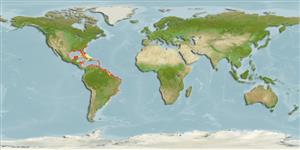分類 / Names
俗名 | 同種異名 | Catalog of Fishes(屬, 種) | ITIS | CoL | WoRMS | Cloffa
Elasmobranchii
板鰓亞綱 (鯊魚與魟魚) (sharks and rays) >
Torpediniformes (Electric rays)
電鰩目 (Electric rays) >
Narcinidae (Numbfishes)
雙鰭電鰩科 (Numbfishes)
Etymology: Narcine: Greek, narke = numbness (Ref. 45335).
Environment: milieu / climate zone / depth range / distribution range
生態學
海洋 礁區魚類; 深度上下限 1 - 43 m (Ref. 13608). 亞熱帶的; 37°N - 39°S, 98°W - 34°W
Western Atlantic: Espirito Santo, Brazil to northern Argentina (Carvalho, pers. comm.). North Carolina, USA to Florida, northern Gulf of Mexico, central Lesser Antilles and Yucatan (Ref. 26938).
西大西洋: 巴西的聖埃斯皮里托到阿根廷北部 (Carvalho , pers. comm.)。 美國北卡羅萊那州到佛羅里達,墨西哥灣北部, 中央的小安地列斯群島與尤卡坦半島.(參考文獻 26938)
Length at first maturity / 大小 / 重量 / 年齡
Maturity: Lm 28.8 range ? - ? cm
Max length : 54.0 cm WD 雄魚/尚未辨別雌雄; (Ref. 26340); common length : 35.0 cm WD 雄魚/尚未辨別雌雄; (Ref. 5217); 最大體重: 650.00 g (Ref. 6902)
簡短描述
檢索表 | 型態特徵 | 形態測量圖
A pale sand-colored ray, often with ellipses of dark spots on dorsal side of rounded disk (Ref. 26938). Grayish to reddish brown, many rounded blotches outlined with blackish spots. Dark bands across tail up to dorsal fin. Snout darkened (Ref. 7251).
一個白沙色的魟, 時常以橢圓形的深色斑點在圓形圓盤的背面兩側上.(參考文獻 26938) 淺灰色的到紅褐色的, 許多圓形的斑塊邊緣有黑色的斑點了。 橫過尾部向上到背鰭的深色條紋。 吻顏色較深。 (參考文獻 7251)
Inhabits coastal waters, on sand or mud bottoms (Ref. 26340). Common along sandy shorelines, sometimes near coral reefs (Ref. 12951). Aggregates in shallow waters ca. 10-20 m deep during summer and autumn months, dispersing to deeper waters during winter (Ref. 114953). Buries itself with only eyes protruding (Ref. 12951). Nocturnal, moves to shallow bays at night to feed; prefers worms, but may take juvenile snake eels, anemones, and, small crustaceans (Ref. 12951). Produces broods of 4 to 15 young (Ref. 26938). Reaches ca. 45 cm TL. Both sexes mature by 27 cm TL; birth size at ca. 11 cm TL (Ref. 114953). Can discharge between 14 and 37 volts. Contact with the skin can produce a severe electric shock. In addition to the main electric organ, this species possesses a bilateral accessory electric organ (Ref. 10011) speculated to have a possible role in social communication (Ref. 10489). Reported to taste good, but not fished commercially. Traded as an aquarium fish at Ceará, Brazil (Ref. 49392).
在沙或泥底部上, 棲息於沿岸水域。 (參考文獻 26340) 普遍的沿著沙質海岸線, 有時在珊瑚礁的附近.(參考文獻 12951) 埋藏它本身,僅僅眼伸出。 (參考文獻 12951) 夜行的, 移動到淺灣在晚上覓食; 偏愛蠕蟲, 但是可能吃蛇鰻幼魚, 卷曲異輻海葵, 與, 小型甲殼動物.(參考文獻 12951) 一窩生產 4 到 15個幼魚。 (參考文獻 26938) 能放電電壓介於 14 與 37 伏特之間。 觸碰皮膚能生產一個嚴重的電擊。 以及主要的發電器,這種持有被深思有一個社會的溝通的可能的角色的一個左右對稱的附屬發電器官 (參考文獻 10011) 。 (參考文獻 10489) 報告嚐起來好, 但是不商業性地漁捕。 在巴西的塞阿臘作為一個水族館魚交易了。 (參考文獻 49392)
Life cycle and mating behavior
Maturities | 繁殖 | Spawnings | Egg(s) | Fecundities | 仔魚
Ovoviviparous. Sex ratio of embryos is about one to one, however, small mothers may have predominantly female embryos and that for a given mother, embryos tend to be of one sex (Ref. 46979). Maximum number of embryos per female may reach 15. The young are capable of giving off electric charges even before they are released from the womb (Ref. 46978).西大西洋: 巴西的聖埃斯皮里托到阿根廷北部 (Carvalho , pers. comm.)。 美國北卡羅萊那州到佛羅里達,墨西哥灣北部, 中央的小安地列斯群島與尤卡坦半島.(參考文獻 26938)
Robins, C.R. and G.C. Ray, 1986. A field guide to Atlantic coast fishes of North America. Houghton Mifflin Company, Boston, U.S.A. 354 p. (Ref. 7251)
IUCN 瀕危狀態 (Ref. 130435)
近危 (NT) (A2d); Date assessed: 01 July 2019
人類使用
漁業: 自給性漁業; 水族館: 商業性
工具
特別的報告
下載 XML
網路資源
Estimates based on models
Preferred temperature (Ref.
123201): 22.9 - 28, mean 25.6 °C (based on 442 cells).
Phylogenetic diversity index (Ref.
82804): PD
50 = 0.5000 [Uniqueness, from 0.5 = low to 2.0 = high].
Bayesian length-weight: a=0.01122 (0.00605 - 0.02082), b=2.90 (2.73 - 3.07), in cm total length, based on LWR estimates for this species & (Sub)family-body (Ref.
93245).
營養階層 (Ref.
69278): 3.2 ±0.4 se; based on diet studies.
回復力 (Ref.
120179): 低的, 最小族群倍增時間4.5 - 14 年 (Assuming fecundity<100).
Fishing Vulnerability (Ref.
59153): Low to moderate vulnerability (34 of 100).
Nutrients (Ref.
124155): Calcium = 6.47 [0.67, 106.25] mg/100g; Iron = 0.472 [0.039, 5.319] mg/100g; Protein = 16.6 [12.4, 21.0] %; Omega3 = 0.145 [0.049, 0.421] g/100g; Selenium = 14.3 [2.3, 70.5] μg/100g; VitaminA = 22.2 [1.8, 283.1] μg/100g; Zinc = 0.82 [0.06, 9.22] mg/100g (wet weight);
